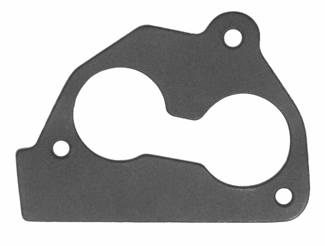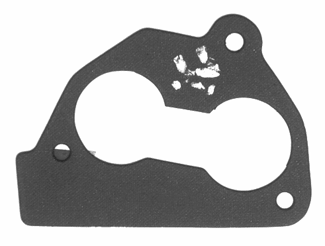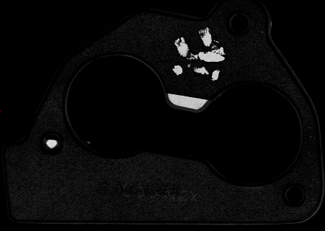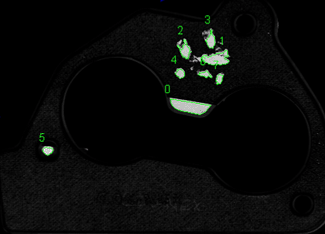CompareImage
CompareImage compares a region of interest with a template image and returns an Image with white pixels where the region does not match the template within a certain tolerance.
CompareImage Overview
CompareImage is designed to extract a template from the current image when the ForceTrain checkbox in the property sheet is selected. After the user deselects the checkbox, CompareImage can map the pixels from the template to the input image for comparison and for producing the greyscale output image. Pixels that do not match the template image within a certain tolerance are displayed as bright or white pixels.
CompareImage Inputs
| Parameters | Description | ||||||||||
|
Image |
This parameter must use Cell References in
a spreadsheet cell that contains an Image data structure; by
default, this parameter references A0, the cell containing the Image data structure returned by |
||||||||||
|
Fixture |
Defines the Region of Interest (ROI) relative to a Fixture input or the output of a Vision Tools function's image coordinate system. Setting the ROI relative to a Fixture ensures that if the Fixture is rotated or translated, the ROI will be rotated or translated in relation to the Fixture. The default setting is (0,0,0), the top leftmost corner of the image.
|
||||||||||
|
Region |
Also known as the Region of Interest (ROI), specifies the region of the image that undergoes analysis. Double-click on the Region parameter to create an Interactive Graphics Mode that you can transform and rotate. Select this parameter and press the Maximize Region button on the Job Edit toolbar of the property sheet to automatically stretch the region to cover the entire image.
|
||||||||||
|
Note: The Fixture and Region parameters must be defined
within the bounds of the image; otherwise, the function will return #ERR.
|
|||||||||||
|
ForceTrain |
Specifies when the template is extracted from the current image: either when the ROI dimensions are modified, or when the ForceTrain parameter is selected.
|
||||||||||
|
Edge Range |
Specifies the number of pixels (0–24; default = 3) around an edge that will be tolerated during the image comparison. The higher the number, the less rigorous the edge matching between the template and the input image (in other words, the less likely imperfectly matched edges will be depicted as differences in the output image). |
||||||||||
|
Interpolation |
Specifies the type of pixel comparison to perform when mapping the template to the input image to produce the output image of the differences.
|
||||||||||
|
Show |
Specifies which graphical overlays are displayed on top of the image.
|
||||||||||
CompareImage Outputs
|
Returns |
An Image data structure containing the processed image, or #ERR if any of the input parameters are invalid. |
CompareImage Example
In this example, the goal is to use CompareImage to compare the template image of a "good" gasket with input images of gaskets on a production line.
First, after inserting CompareImage into the spreadsheet, the user defines the ROI by double-clicking on the word "Region" in the property sheet, which disappears to reveal the red ROI box overlaid on the image. The user moves or resizes the box using the cursor, and clicks the OK ![]() button on the Job
Edit toolbar (or presses the Enter key) to confirm the selection and return to the property sheet.
button on the Job
Edit toolbar (or presses the Enter key) to confirm the selection and return to the property sheet.
Next, the user fixtures the tool to another data structure. In fixturing, the user identifies a distinctive feature that appears on all instances of the object and designates it as a reference point for subsequent vision tools. This allows precise comparisons or inspections to be made, even if the object is slightly rotated or shifted on the production line.
To fixture the function, the user clicks the word "Fixture" in the property sheet and clicks either the Absolute Reference ![]() or
Relative Reference
or
Relative Reference ![]() button on the property sheet's toolbar.
button on the property sheet's toolbar.
The property sheet disappears, revealing the In-Sight spreadsheet. The user moves the cursor to select the Row, Column and Angle cells from another data structure in the spreadsheet (for example, FindPatterns) as the reference for the fixture, and clicks the OK ![]() button on the Job
Edit toolbar (or presses the Enter key) to confirm the selection and return to the property sheet.
button on the Job
Edit toolbar (or presses the Enter key) to confirm the selection and return to the property sheet.
Then, the user ensures that the ForceTrain checkbox in the property sheet is selected, so that a template image (below) can be extracted automatically when an image acquisition is manually triggered. (However, simply selecting the ForceTrain checkbox triggers the image acquisition, so if the current image is acceptable, the user can skip setting up the image and manually triggering the acquisition.) Once a template is selected, the user deselects the checkbox to prevent overwriting the template.

Accepting the default settings of the other parameters and clicking OK in the property sheet completes the configuration for this example and applies the function to the input image.
During run time, the tool compares the template image with the input image. A "bad" input image might consist of a gasket marred by white marks (below).

Differences between the two are displayed as bright pixels in the greyscale output image (below).

Another tool (for example, DetectBlobs; see below) can reference the output image to make a decision about whether the gasket passes or fails inspection.
